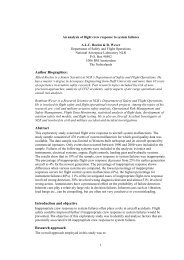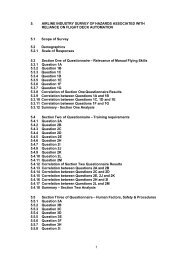- Page 1: Causal risk models of air transport
- Page 4 and 5: Dit proefschrift is goedgekeurd doo
- Page 6 and 7: Acknowledgements A PhD study has be
- Page 8 and 9: Chapter 6. Risk models in other ind
- Page 10 and 11: List of abbreviations AC Advisory C
- Page 12 and 13: STAR Standard Arrival Route STCA Sh
- Page 16 and 17: processes? The second dimension is
- Page 18 and 19: Chapter 2. Fundamentals of risk Bef
- Page 20 and 21: Figure 1: Voluntary exposure to ris
- Page 22 and 23: Y (RDC) [km] 495 490 485 480 475 47
- Page 24 and 25: achieved (i.e. an aspirational targ
- Page 26 and 27: accidents’ because these accident
- Page 28 and 29: e restricted to ‘objective’ ris
- Page 30 and 31: is irrelevant. The fire-fighter wil
- Page 32 and 33: In this example, the drug appears b
- Page 34 and 35: ender the model outcome too uncerta
- Page 36 and 37: If we adopt Leveson’s [2004a] sys
- Page 38 and 39: models. A strategy for avoiding thi
- Page 40 and 41: Number of accidents per 100,000 fli
- Page 42 and 43: After World War II aviation became
- Page 44 and 45: about 100 potential system failure
- Page 46 and 47: Airways 25 , although this is excep
- Page 48 and 49: Douglas DC-10; an aircraft with a t
- Page 50 and 51: of small airlines that went bankrup
- Page 52 and 53: Throughout the service life of an a
- Page 54 and 55: an inverse relation should exist be
- Page 56 and 57: Safety versus the environment: the
- Page 58 and 59: A causal risk model could support t
- Page 60 and 61: adequate levels of safety in the ci
- Page 62 and 63: also because of the large amount of
- Page 64 and 65:
met. The explanatory material empha
- Page 66 and 67:
Article 8 of the Seveso Directive (
- Page 68 and 69:
4.4. Summary of user requirements a
- Page 70 and 71:
Grouped by type of requirements, th
- Page 72 and 73:
Representation of regulation Regula
- Page 74 and 75:
characteristics make test pilots ve
- Page 76 and 77:
Table 3: List of fatal flight test
- Page 78 and 79:
4.5. User expectations: lessons fro
- Page 80 and 81:
helpful tool. This will have to be
- Page 82 and 83:
is to have a top-level representati
- Page 84 and 85:
Chapter 5. Examples of aviation saf
- Page 86 and 87:
therefore the approach cannot be co
- Page 88 and 89:
N az ⎡ ⎪⎧ 2λ y& z ⎪⎫ ⎤
- Page 90 and 91:
acceptable. The question, scope and
- Page 92 and 93:
Chapter 6. Risk models in other ind
- Page 94 and 95:
support [Paté-Cornell & Dillon 200
- Page 96 and 97:
Techniques that have been used in t
- Page 98 and 99:
airline passengers face. A complica
- Page 100 and 101:
problems, already well accepted in
- Page 102 and 103:
computationally more intensive. A d
- Page 104 and 105:
BASIC EVENT - A basic initiating fa
- Page 106 and 107:
fault trees best represent the logi
- Page 108 and 109:
Bayesian Belief Nets are convenient
- Page 110 and 111:
The approach for CATS was with q =
- Page 112 and 113:
PDPs can be used to construct model
- Page 114 and 115:
analysis is repeated for each secti
- Page 116 and 117:
Chapter 8. Quantification The causa
- Page 118 and 119:
hole’ is impossible to tell unles
- Page 120 and 121:
An example of a complex issue for w
- Page 122 and 123:
determined, given the results of th
- Page 124 and 125:
Indeed it can be misleading to thin
- Page 126 and 127:
determine what preventive action ma
- Page 128 and 129:
to provide quantitative data to the
- Page 130 and 131:
data the most accurate and detailed
- Page 132 and 133:
It takes years to set up and conduc
- Page 134 and 135:
Another problem with the use of aud
- Page 136 and 137:
Ambiguity in the classification sys
- Page 138 and 139:
vulnerable to differences in interp
- Page 140 and 141:
Chapter 9. Modelling challenges In
- Page 142 and 143:
considerable procedure guidance, do
- Page 144 and 145:
Procedures Availability Error proba
- Page 146 and 147:
9.2. Modelling safety management IC
- Page 148 and 149:
phenomenon 73 . As a matter of fact
- Page 150 and 151:
shift changeovers or when an aircra
- Page 152 and 153:
will be crossed if no action is tak
- Page 154 and 155:
capsule, Grissom realized that he w
- Page 156 and 157:
According to this model, ‘fatigue
- Page 158 and 159:
Archetype accident example 1: Take-
- Page 160 and 161:
Table 8: Runway overrun accidents a
- Page 162 and 163:
evolution 78 . An advantage of this
- Page 164 and 165:
systems. They then provide a conven
- Page 166 and 167:
that the rest contains no ‘new’
- Page 168 and 169:
quick handling by the flight crew a
- Page 170 and 171:
Cumulative probability 1 0.9 0.8 0.
- Page 172 and 173:
speed 86 for the 500 ft altitude ga
- Page 174 and 175:
Probability density 0.0008 0.0007 0
- Page 176 and 177:
This example concerns an approach f
- Page 178 and 179:
10.6. Conclusions for this section
- Page 180 and 181:
accident chains in which the ultima
- Page 182 and 183:
esults are being used in a certific
- Page 184 and 185:
are not ‘calibrated’. These asp
- Page 186 and 187:
equirements. The degree to which dy
- Page 188 and 189:
this may seem to be an oversimplifi
- Page 190 and 191:
Main research question: What does c
- Page 192 and 193:
References AAIASB. (2006). Accident
- Page 194 and 195:
BEA. (2001). Accident on 25 July 20
- Page 196 and 197:
Carpenter, M.S., Cooper, L.G., Glen
- Page 198 and 199:
EAI. (2002). Review of Causal Model
- Page 200 and 201:
FAA. (1995a). Aviation safety actio
- Page 202 and 203:
Hale, A.R. (2000). Railway safety m
- Page 204 and 205:
IATA. (2008b). IOSA Standards Manua
- Page 206 and 207:
Khatwa, R., Roelen, A.L.C. (1996).
- Page 208 and 209:
Lloyd, E. (1980). The development o
- Page 210 and 211:
Nijenhuis, W.A.S., Spek, F., Moelek
- Page 212 and 213:
Onisko, A., Druzdzel M.J., Wasyluk,
- Page 214 and 215:
around airports, Part 1: Main repor
- Page 216 and 217:
Simons, M., Valk, P.J.L. (1998). Ea
- Page 218 and 219:
Tweede Kamer. (2003b). Toekomst van
- Page 220 and 221:
Summary Aviation safety is so well
- Page 222 and 223:
existing data bases. Preferably the
- Page 224 and 225:
verder verbeteren daarvan, zijn er
- Page 226 and 227:
internationale regelgever zoals EAS
- Page 228 and 229:
LPG [Tweede Kamer 1983], which set
- Page 230 and 231:
of this a situation has been create
- Page 232 and 233:
Holding En-route Approach Go-around
- Page 234 and 235:
Approximately 5 minutes prior to de
- Page 236 and 237:
cockpit announcing flight parameter
- Page 238 and 239:
The ground controller then takes ov
- Page 240 and 241:
aircraft input will occur. They wil
- Page 242 and 243:
Basic principles for the design, co
- Page 244 and 245:
egulation became evident and the In
- Page 246 and 247:
its functions was to develop and ad
- Page 248 and 249:
the delivery systems determines a m
- Page 250:
244




